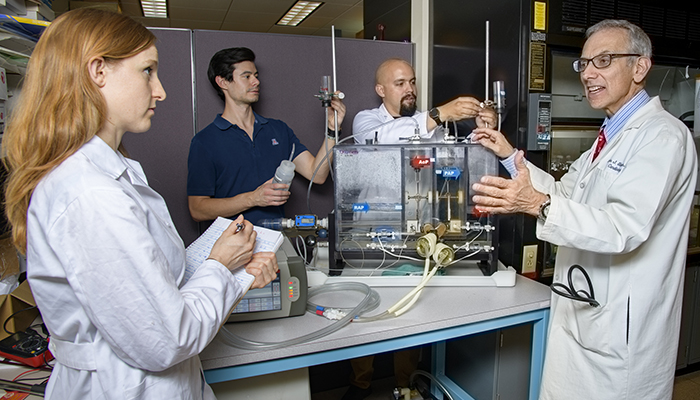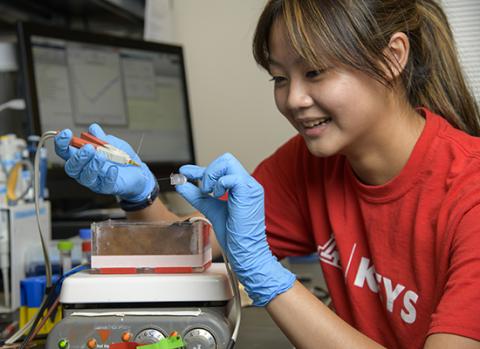
Yi-Jen Yang is entering her junior year at Oro Valley BASIS High School, but she held her own this past summer working side-by-side with undergraduate, graduate and post-doctoral students, as well as UA faculty members, in a major laboratory at the University of Arizona.
The 16-year-old spent the summer working in a laboratory headed by internationally noted physician-scientist Marvin J. Slepian, MD, Regents’ Professor and professor of medicine, professor and associate department head of biomedical engineering and a McGuire Scholar in the Eller College of Management at the UA. As a member of the lab team, Yang conducted research, presented findings and helped make real-world biomedical research advancements.
Funded primarily by grants from the National Institutes of Health, the Slepian Lab is based at the Arizona Center for Accelerated Biomedical Innovation (ACABI), a translational research-and-development center, founded and directed by Dr. Slepian and supported and funded by the UA Health Sciences and Tech Launch Arizona. ACABI serves as a university-wide creativity center, functioning as an “inventor’s workshop” for UA faculty, students and the domestic and global communities.

And she found Dr. Slepian extremely supportive. “It was so nice to hear someone so strongly support my passion for medicine and science.”
“Providing a lab experience early on for students allows them to see firsthand that they too can get involved, become scientists, engineers and innovators and make a difference,” Dr. Slepian says. “It converts what seems too far-reaching and complicated to something real, fun and tangible! Our entire lab always emphasizes to students the value of science, engineering, research investigation and creativity for our collective future. The concept is that these students will become next-generation problem-solvers – as physicians, biomedical engineers or other health professionals – and, more broadly, as biomedical innovators,” adds Dr. Slepian, also a member of the UA Sarver Heart Center and the UA BIO5 Institute.
And innovation long has been a hallmark of the Slepian Lab and ACABI. Over the years, Dr. Slepian’s laboratory has focused on the development and use of novel biomaterials for tissue engineering, drug delivery and medical device development.
The lab has developed many novel diagnostics and therapeutics now in clinical use, including: drug-eluting stent technologies; stent coatings; “polymer paving,” surgical anti-adhesive barriers; stretchable and biodegradable electronics; synthetic tissue sealants; and cardiovascular prosthetic devices, including the total artificial heart. The lab also collaborated on the development of a device used in the emergency room, operating room and blood banks that delivers life-saving platelet function data to the health-care provider in 6 minutes at the point of care.
Lucas Hawley, a UA sophomore majoring in biomedical engineering, first became interested in research as a high school student when he attended an Engineering Academy at the UA and spent time in Dr. Slepian’s lab.
“That’s how I began at the lab,” says Hawley, who now works at the lab and wants to attend medical school and focus on wilderness medicine. “I’ve always been interested in research so this has been a huge opportunity for me. It has simply been amazing to be involved in the projects in this lab. And if you don’t like your project, you can move on to a different project.”
Kaitlyn Ammann, PhD, a postdoctoral research associate in the lab who studies vascular and wearable devices, helps mentor the younger students.
“I think the lab is pretty unique in that we actually want the younger students to work on research projects that will contribute to the field they’re interested in.”
Some of the high school students have had their names included on academic journal articles, she says.
“I think the students are always surprised how much work goes into such articles. But the ones who decide to stick it out and put the work into it get their names on papers.”
Yang was placed in the Slepian Lab through her participation in the UA’s selective summer internship program, KEYS (Keep Engaging Youth in Science).
“I am contributing to the research and development of a new point-of-care device known as the MICELI chip. To better understand a patient’s capability to stop bleeding on their own, this device tests whether their blood has functioning platelets that can properly aggregate and coagulate.”
The laboratory experience further has inspired Yang to pursue a career in medicine.
“My main educational goals are to attend the University of Arizona and major in bioinformatics and business, along with a pre-med track. After my undergraduate years, I hope to attend medical school at the UA. I love children and I love research so it would be an absolute honor if I could work in the children’s hospital of the future.”
This story was featured in the University of Arizona's Wildcat Country 2019. View the PDF to read more stories.

